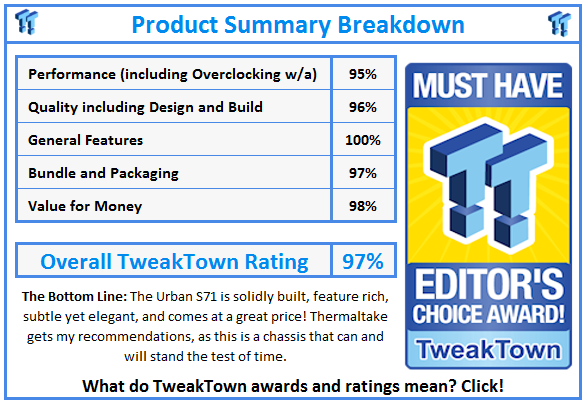Introduction
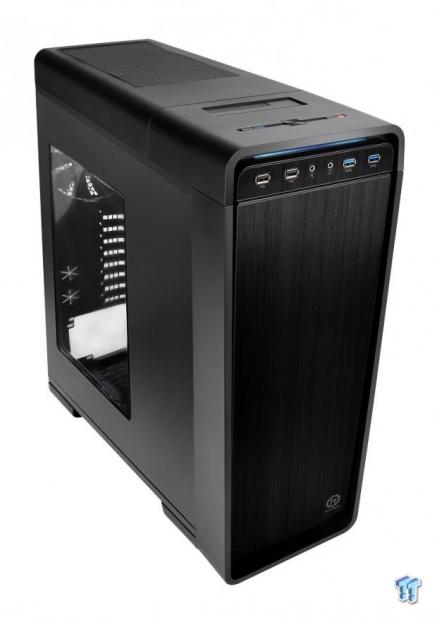
From what we have seen in the Chaser A71 chassis recently, there may be a few things that would keep someone from buying one. There is the light blue accent coloration that may not work with your build plans. There was also a really aggressive design with sharp points on the protruding plastic used on the top and the front bezel. The last reason may very well be that when you look for a chassis with a window, you want to actually see what is inside, rather than having to look through a 200mm fan. The nice thing is that Thermaltake may very well still have an answer for your needs as well.
Essentially, the core frame of these chassis designs follow right along with what was found in the Chaser series. This means if the feature set of the Chaser A71 and the layout on the inside of the chassis was something you could see yourself using, moving over to the Urban series gives you a similar foundation. Aesthetically things have changed with the external layout and design, to give a rounded, sleeker, and more subdued external look. I for one am one of those who really liked what the Chaser A71 has to offer, but the styling is too aggressive for my taste to spend any real-time on my desk, and from what I have already gathered in looking at the first Urban chassis design, I really like what I am seeing.
Today we are going to be looking at the largest and best equipped offering in the Urban series with the S71 full-tower chassis. For starters, things are much more rounded for a softer appearance, the light blue accents are gone, but Thermaltake kept things that are most important like great front I/O panel access and a HDD dock, but also does things like adding a front door, changing the windowed side panel, and even adding a basic fan controller.
From what I can tell Thermaltake is really stepping up their game with the release of these new chassis designs, and the Urban S71 is one of those chassis designs that will fit in to most decors or themes, and suits a much wider audience. This is never a bad thing to widen your market, and I really think it is worth the time and energy to stick with me as we get in depth with this new chassis from Thermaltake.
Editor Note: For this review we are using press images provided by Thermaltake. After the product was returned, we had an image disaster, which left us without our own images.
Specifications, Availability and Pricing

This mainly SECC steel chassis measures 21" tall, 8.4" wide and is 23" from front to back, weighing in at 23.2 pounds, empty. This full-tower chassis offers a side panel window that is not tinted in any way. Around the S71 you will find three external 5.25" bays and the fourth bay in that rack has a 3.5" adapter shipped in it to allow for a card readers or similar add-in devices. Internally the S71 is given five slide-out trays in an immovable rack, and these trays allow for 3.5" drives using screws through the side of the trays, and for 2.5" drives you would need to use screws through the bottom. Speaking of storage, you also have a hot-swap storage dock on top of the chassis for either a 2.5" or 3.5" drive. The motherboard tray will house Micro-ATX, ATX, as well as E-ATX motherboards, has superb wire management options, and a large cut-out for CPU cooler installation access.
The front I/O panel of the chassis offers the typical pair of USB 3.0 ports and a pair of USB 2.0 ports as well. Along with the power button, reset button, HD Audio 3.5mm jacks, you are also given a two stage fan controller with the Urban series that the Chaser did not offer. This fan controller powers all three of the stock fans that ship inside the S71. These consist of a matched pair of black bladed, no LED, 200mm fans. One of them comes shipped in the front of the chassis, while the other comes shipped in the top. The third fan that comes inside of the chassis is the 120mm black fan that is strapped to the rear of the chassis, as exhaust. The floor of the chassis does offer an additional location to place a fan, and you have the choice of 120mm or 140mm options in fans.
As was found with the Chaser A71, most locations that are offering the new Urban S71 are selling them at the exact same price point of $139.99. Shopping around is something you will want to do with the Urban S71 as well. Out of the 25 or so locations showing via Google, prices start at $136 with shipping included, and I even see listings at the $200 mark. Pay close attention when looking to buy this chassis as there is a huge swing in pricing, and there is no need to pay that much at all. Considering I liked the Chaser so much at this pricing, there is a bit of give and take with the features and aesthetics, but they are very evenly matched. The real decision at this point is very basic; you just need to make the call on an aggressive chassis or a more sophisticated appearance.
We already know that I think the Chaser was feature rich and sturdy, so there is no conceivable reason why I should not feel the same way about the Thermaltake Urban S71 we are about to see in some depth over the next few pages.
Packaging

Thermaltake packs the Urban S71 in a black and light blue package. This allows the up close image of the S71 placed here to be highlighted with the blurred out geometric shapes. In the bottom, right hand corner, you will also see that this chassis has Native USB 3.0 support. The reverse of the packaging is identical to what is shown here.

Beneath the thick red stripe you will find four features being listed in 12 languages in total. They cover the I/O panel offering USB 2.0 and USB 3.0, the included fans, the drive bay configuration, and the support for water cooling and advanced cable management.

This last panel of the packaging offers a look at two chassis versions, one with a plain left side panel, and the windowed version. Below these chassis images you will find the specifications of it, just like the chart we just went over on the last page.
Going with the basics is never a bad idea, as long as it works. With the inner packaging, Thermaltake went with the plastic liner, cling plastic for the windows, both to protect from scratches to the paint and plastic bits while thick Styrofoam is used to protect and center the chassis so that a slight drop or poke into the box does not result in damage. And yes it worked, as our sample arrived in great shape.
Thermaltake Urban S71 Full-Tower Chassis
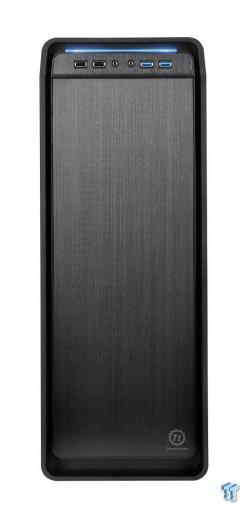
The Urban S71 is rounded at the top and bottom, and offers a huge aluminium door that is brushed and marked with the Thermaltake logo. Then you can spot the front I/O panel above that door.

The door is slightly skinnier than the overall bezel, and a bit shorter, to allow air into the chassis. Behind the door you have four removable bay covers above this image. Here there is a large removable ventilated cover with a dust filter for the fan behind it.

The front I/O panel starts with a pair of USB 2.0 ports to the left. These are followed with the 3.5mm jacks for headphones and a microphone use via the HD Audio header. Then to finish it out, Thermaltake also offer the USB 3.0 ports to the right. The rest of the chassis controls are found at the top. The left side offers a low or high setting fan controller. You then have a large power button in the middle. Off to the right, you will find the smaller reset button and red LED light for the HDD activity. Just behind all of this, you will also see the 2.5" or 3.5" HDD dock.

Behind the dock you will find a long expanse of steel mesh with tiny round holes in it to allow the fan or fans under it a way to exhaust through the chassis. The roundness we saw on the front is also carried all the way to the back with the thick plastic surrounding the mesh panel. Thermaltake also adds a removable dust filter for this as well.

The left side of the Urban S71 offers a really great window. The panel is flat, so that allows for a large window to go in. While they take up most of the vertical height, they don't go too far horizontally as to make you look at bays and wiring.

Out back of the chassis, at the top you can see a dust filter in the top section of plastic, ad as you move to the steel, you first see the wire tending loop. There is a 120mm fan placed next to the rear I/O, eight expansion slots, the pair of LCS holes with grommets, the PSU, and another dust filter handle at the bottom.
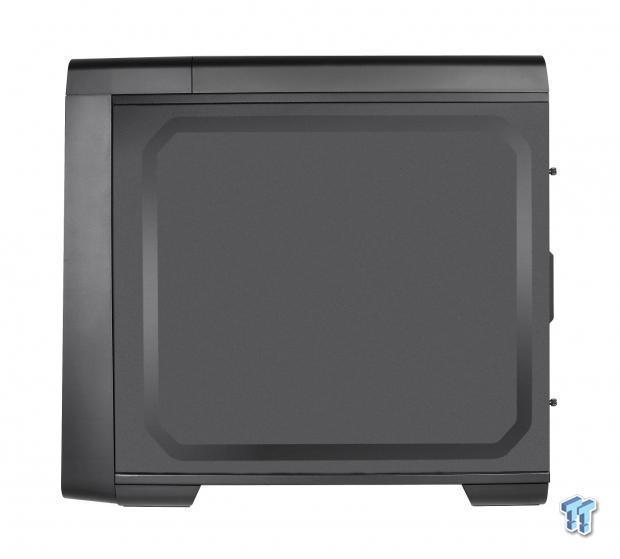
The right side panel may be pretty plain and solid black, but the important thing here is that most of the panel is bumped out near 15mm for extra room for the chassis wiring to fit behind it.
Inside the Urban S71

With the door screws removed and the panel slid back and pulled off the chassis, you get to see inside the Urban S71. This is the same interior found in the Chaser A71, but this time the fans are different. The wiring was nicely tied and run through a grommet to limit its motion in transit, and the hardware was found in the HDD rack.

There are three full on 5.25" bays, and all three use these tool-free clips that are very secure in locking in a device. The bottom bay has a built in conversion to allow a 3.5" drive to be installed, and the ODD rack is cut away to gain access to the screw holes.

Behind the 200mm fan blowing into the chassis you find a rack that will support five devices in these slide-out plastic trays. You will need to use screws to mount either a 2.5" drive or a 3.5" drive because there aren't any tabs to make life a little easier when mounting 2.5" drives.
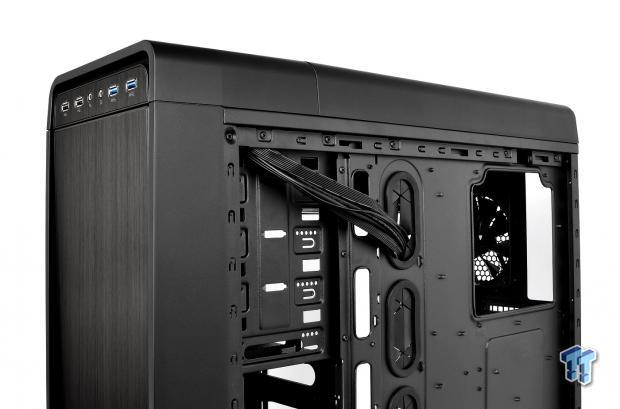
Most of the chassis wiring starts at the same point, and if you don't care too much about the wires, you can leave them routed as it comes out of the box. Since there is 15mm of room from the chassis to the tray, plus the additional 15mm in the door panel, you can get quite a bit of wiring anywhere you want really.
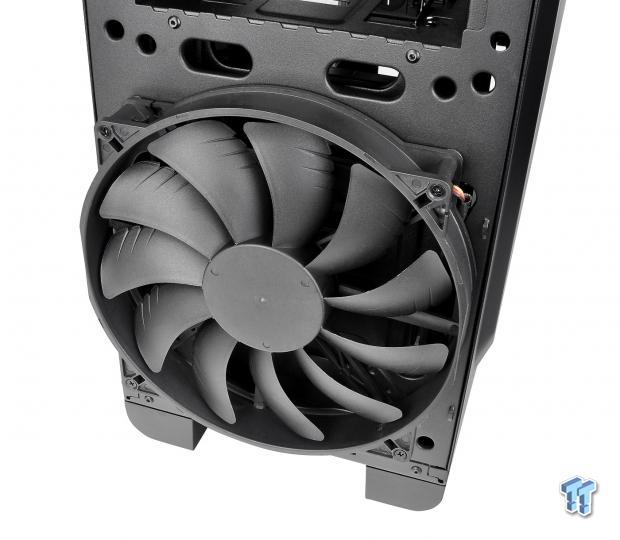
After removing the front bezel of the chassis, you can see that the fan is mounted externally, making it very easy to access and clean. I did not remove this fan to see if there is 120mm fan mounting, but the specs chart made no mention of 120mm fan acceptability either.
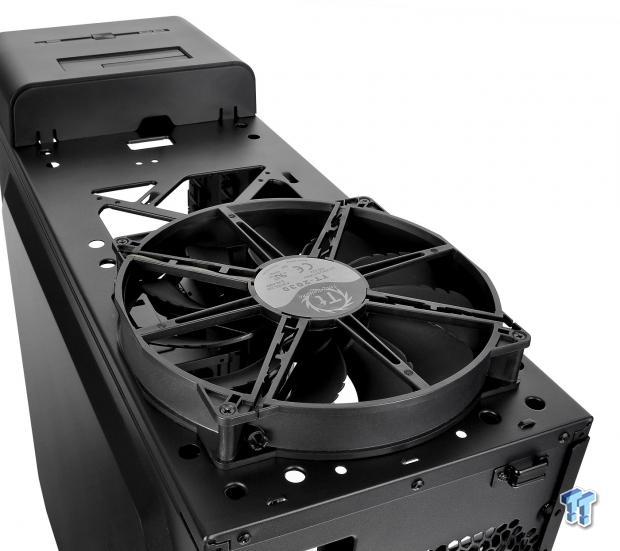
Removing the top is a bit challenging, but under it you will find the stock TT-2030 fan installed. Of course so that you can fit all of the AIO solutions they provide in the Water2.0 kits, you also have the option to remove this fan for a pair of 120mm fans.
The Build and Finished Product

With the board, NiC cooler, video card and PSU installed, even without the wiring currently present, you can see there is plenty of room left inside to work on things and you should have no issues using the nine wire management holes to complete your build.
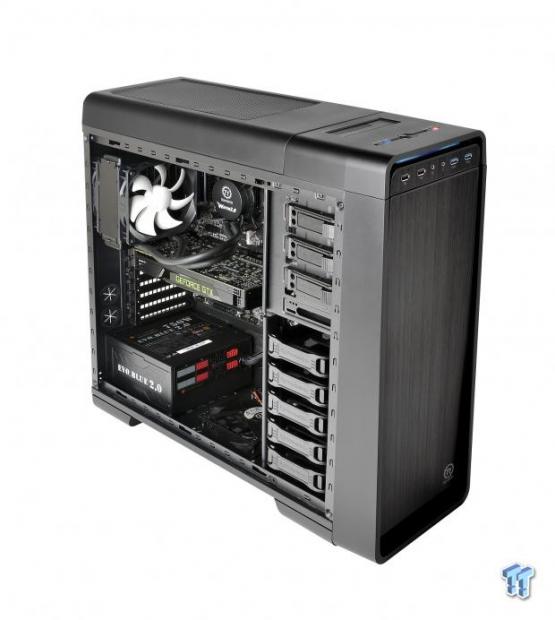
In this image you can see that the Water2.0 Pro fits without issue as well. You also can add an optional fan to the floor as seen here, but you will need to take care to wire the PSU right as not to block the flow of said fan.

The HDD dock in the top of the chassis will take both a 2.5" drive through the smaller door, and it also takes the 3.5" drive seen here as both the smaller and larger doors fold out of the way to allow for this to happen.

As you can see from this image, out of the box, the Urban S71 uses a negative air pressure system. I know they show the flow coming in through the floor, but remember that is optional. This leaves the front fan blowing in, and the top and rear exhaust fans taking out more air than is moving into the chassis. Also not that this time the Water2.0 Extreme has been installed to replace the top 200mm fan.
Since we saw the LED lighting of the front of the chassis with the blue strip glowing and the fan controller and HDD activity lights already illuminated in previous images, I felt another image here would be redundant. The lighting is pretty bright, but most users will only see the front blue line of LED, and it isn't so bright as to blind you or keep you from sleeping in the same room.
Final Thoughts
The Thermaltake Urban S71 full-tower chassis is a case that resembles other rounded chassis designs on the outside, but Thermaltake delivers this one with a unique way of doing this. I am a real sucker when it comes to rounded chassis designs too, as my TJ11 and Fractal Design ARC Midi R2 that are on my desks currently will attest to. This chassis falls in the middle of both of these, in my opinion. While not as elegant as the TJ11, the S71 adds a splash of brushed aluminum, rounded exterior corners at the top and bottom, and an overall theme that leaves the S71 with a subtle, but sophisticated feel. Overall I like the feature set, I like the roominess inside, and it is awfully hard to hate on the way this chassis looks - I don't care who you are. This is sleek and sexy.
The majority of the build went well, with no real issues to discuss of faulty parts or something not working or installing, as it should. There is little room above the motherboard for much more than fans inside the chassis, but with the raised top panel on the Urban S71, you can put the radiator on to, and cover it, or put the radiator inside and have the fans in the top of the chassis. If I really dug deep and thought about really trying to pick this chassis apart, there is only one thing that may be a deal breaker for some, and that is the left hand swing of the front door.
To me if the window is on the left of a chassis, the front panel should open to the right to get out of the users way. With the Urban S71, this just isn't what they give you. Another thing you may need to consider, since there is a full sized door on the front of this chassis, it does limit the inflow of air to the front of the chassis, and because of this, temperatures are three degrees higher inside of this chassis rather than what I got with the Chaser version. The Chaser also has the 200mm side fan that this does not have, and that plays a large part in it as well - just something to ponder.
Costing the same as the Chaser A71 is nice to see, and it really gives users a very different way to see the design now that we have seen the Urban S71. Both being averagely priced at $139.99 in most locations makes this another chassis that really delivers a fully featured full-tower chassis, that doesn't break the magic $150 mark, where most users have as a cutoff for what they will spend on a chassis.
As much as I liked what I saw with the first chassis like this, the Urban S71 is a stunning looking, full featured solution that is well worth the investment and one that can grow as your needs and desires change over time.


